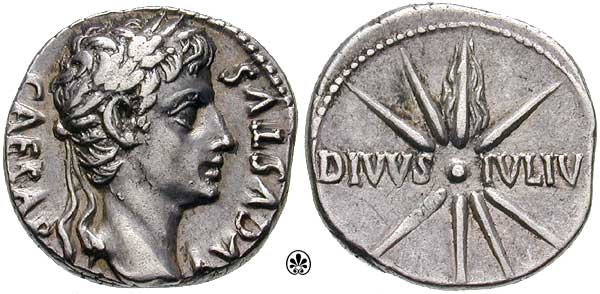Coinage reform of Augustus on:
[Wikipedia]
[Google]
[Amazon]
 The coinage reform of Augustus refers to the reform of
The coinage reform of Augustus refers to the reform of
 The coinage reform of Augustus refers to the reform of
The coinage reform of Augustus refers to the reform of Roman currency
Roman currency for most of Roman history consisted of gold, silver, bronze, orichalcum and copper coinage. From its introduction to the Republic, during the third century BC, well into Imperial times, Roman currency saw many changes in form, denom ...
undertaken by Augustus
Caesar Augustus (born Gaius Octavius; 23 September 63 BC – 19 August AD 14), also known as Octavian, was the first Roman emperor; he reigned from 27 BC until his death in AD 14. He is known for being the founder of the Roman Pr ...
in 23 BC.
The reform
Augustus brought the minting ofgold
Gold is a chemical element with the symbol Au (from la, aurum) and atomic number 79. This makes it one of the higher atomic number elements that occur naturally. It is a bright, slightly orange-yellow, dense, soft, malleable, and ductile ...
and silver
Silver is a chemical element with the symbol Ag (from the Latin ', derived from the Proto-Indo-European ''h₂erǵ'': "shiny" or "white") and atomic number 47. A soft, white, lustrous transition metal, it exhibits the highest electrical ...
coins, the '' aureus'' and denarius
The denarius (, dēnāriī ) was the standard Roman silver coin from its introduction in the Second Punic War to the reign of Gordian III (AD 238–244), when it was gradually replaced by the antoninianus. It continued to be minted in very ...
, under his personal control without changing their weight or fineness. The gold ''aureus'', weighing about one-quarter ounce
The ounce () is any of several different units of mass, weight or volume and is derived almost unchanged from the , an Ancient Roman unit of measurement.
The avoirdupois ounce (exactly ) is avoirdupois pound; this is the United States customa ...
, was worth twenty-five silver denarii, weighing about one-eighth of a troy ounce.
Augustus more comprehensively reformed denominations below the denarius. New ratios were fixed among the currencies: the sestertius
The ''sestertius'' (plural ''sestertii''), or sesterce (plural sesterces), was an ancient Roman coin. During the Roman Republic it was a small, silver coin issued only on rare occasions. During the Roman Empire it was a large brass coin.
The ...
was now minted from about an ounce of orichalcum, an alloy of copper
Copper is a chemical element with the symbol Cu (from la, cuprum) and atomic number 29. It is a soft, malleable, and ductile metal with very high thermal and electrical conductivity. A freshly exposed surface of pure copper has a pink ...
and zinc
Zinc is a chemical element with the symbol Zn and atomic number 30. Zinc is a slightly brittle metal at room temperature and has a shiny-greyish appearance when oxidation is removed. It is the first element in group 12 (IIB) of the periodi ...
, rather than silver, and fixed at a quarter of a denarius
The denarius (, dēnāriī ) was the standard Roman silver coin from its introduction in the Second Punic War to the reign of Gordian III (AD 238–244), when it was gradually replaced by the antoninianus. It continued to be minted in very ...
. The dupondius, formerly a two- pound bronze
Bronze is an alloy consisting primarily of copper, commonly with about 12–12.5% tin and often with the addition of other metals (including aluminium, manganese, nickel, or zinc) and sometimes non-metals, such as phosphorus, or metalloids suc ...
coin, was now orichalcum, valued at half a sestertius and weighing half as much. The half-ounce '' as'', worth half a dupondius, the semis
The semis, literally meaning half, was a small Roman bronze coin that was valued at half an as. During the Roman Republic, the semis was distinguished by an 'S' (indicating semis) or 6 dots (indicating a theoretical weight of 6 uncia). Some o ...
, worth half an ''as'', and the quadrans
The quadrans (literally meaning "a quarter") or teruncius ("three unciae") was a low-value Roman bronze coin worth one quarter of an as. The quadrans was issued from the beginning of cast bronze coins during the Roman Republic with three p ...
, worth half a semis, were the first pure copper coins minted in Rome since 84 BC.
References
Coins of ancient Rome Augustus {{AncientRome-stub